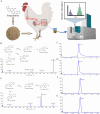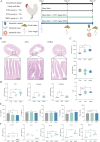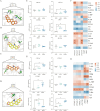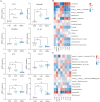Dihydrosanguinarine enhances tryptophan metabolism and intestinal immune function via AhR pathway activation in broilers
- PMID: 40615887
- PMCID: PMC12232056
- DOI: 10.1186/s40104-025-01220-x
Dihydrosanguinarine enhances tryptophan metabolism and intestinal immune function via AhR pathway activation in broilers
Abstract
Background: Tryptophan is essential for nutrition, immunity and neural activity, but cannot be synthesized endogenously. Certain natural products influence host health by modulating the gut microbiota to promote the production of tryptophan metabolites. Sanguinarine (SAN) enhances broiler immunity, however, its low bioavailability and underlying mechanisms remain unclear. This study aimed to decode the mechanisms by which sanguinarine enhances intestinal immune function in broilers.
Methods: Liquid chromatography-tandem mass spectrometry (LC-MS/MS) was employed to identify the main metabolites of sanguinarine in the intestine. Subsequently, equal concentrations of sanguinarine and its metabolites were separately added to the diets. The effects of sanguinarine and its metabolites on the intestinal immune function of broiler chickens were evaluated using 16S rRNA gene amplicon sequencing and tryptophan metabolomics approaches.
Results: We determined that dihydrosanguinarine (DHSA) is the main metabolite of sanguinarine in the intestine. Both compounds increased average daily gain and reduced feed efficiency, thereby improving growth performance. They also enhanced ileal villus height and the villus-to-crypt (V/C) ratio while decreasing crypt depth and upregulating the mRNA expression of tight junction proteins ZO-1, occludin and claudin-1. Furthermore, both compounds promoted the proliferation of intestinal Lactobacillus species, a tryptophan-metabolizing bacterium, stimulated short-chain fatty acid production, and lowered intestinal pH. They regulated tryptophan metabolism by increasing the diversity and content of indole tryptophan metabolites, activating the aryl hydrocarbon receptor (AhR) pathway, and elevating the mRNA levels of CYP1A1, CYP1B1, SLC3A1, IDO2 and TPH1. Inflammatory cytokines IL-1β and IL-6 were inhibited, while anti-inflammatory cytokines IL-10 and IL-22, serum SIgA concentration, and intestinal MUC2 expression were increased. Notably, DHSA exhibited a more pronounced effect on enhancing immune function compared to SAN.
Conclusions: SAN is converted to DHSA in vivo, which increases its bioavailability. DHSA regulates tryptophan metabolism by activating the AhR pathway and modulating immune-related factors through changes in the gut microbiota. Notably, DHSA significantly increases the abundance of Lactobacillus, a key tryptophan-metabolizing bacterium, thereby enhancing intestinal immune function and improving broiler growth performance.
Keywords: Broiler; Gut microbiota; Intestinal immunity; Sanguinarine; Tryptophan metabolism.
© 2025. The Author(s).
Conflict of interest statement
Declarations. Ethics approval and consent to participate: The research adhered to animal experimentation ethics standards and received approval from the Research Ethics Committee of the College of Veterinary Medicine, Hunan Agricultural University (HAU 20240220). Consent for publication: All authors listed on the paper have reviewed and agree to the journal’s Publication Ethics policies. Competing interests: The authors declare that they have no conflict of interest regarding the publication of this article.
Figures






Similar articles
-
Dietary curcumin supplementation enhances growth performance and anti-inflammatory functions by modulating gut microbiota, microbiota-derived metabolites, and expression of inflammation-related genes in broilers.J Anim Sci. 2024 Jan 3;102:skae296. doi: 10.1093/jas/skae296. J Anim Sci. 2024. PMID: 39324614
-
Integrative multi-omics and bioinformatics analysis of the effects of BaiRui YuPingFeng Powder on intestinal health in broilers.Front Vet Sci. 2025 Jun 18;12:1606531. doi: 10.3389/fvets.2025.1606531. eCollection 2025. Front Vet Sci. 2025. PMID: 40607343 Free PMC article.
-
Compound of Lactobacillus reuteri and Candida rugosa supplementation alleviates intestinal barrier lesion via improving the gut microbiota in broilers infected with Salmonella Typhimurium.Poult Sci. 2025 Jun 11;104(9):105417. doi: 10.1016/j.psj.2025.105417. Online ahead of print. Poult Sci. 2025. PMID: 40541101 Free PMC article.
-
Effect of Fermented Feed on Growth Performance and Gut Health of Broilers: A Review.Animals (Basel). 2025 Jul 3;15(13):1957. doi: 10.3390/ani15131957. Animals (Basel). 2025. PMID: 40646856 Free PMC article. Review.
-
Signs and symptoms to determine if a patient presenting in primary care or hospital outpatient settings has COVID-19.Cochrane Database Syst Rev. 2022 May 20;5(5):CD013665. doi: 10.1002/14651858.CD013665.pub3. Cochrane Database Syst Rev. 2022. PMID: 35593186 Free PMC article.
Cited by
-
Neutral Sodium Humate Modulates Growth, Slaughter Traits, Antioxidant Status, and Gut Health in Yellow-Feathered Broilers.Animals (Basel). 2025 Jul 19;15(14):2142. doi: 10.3390/ani15142142. Animals (Basel). 2025. PMID: 40723605 Free PMC article.
References
-
- Comai S, Bertazzo A, Brughera M, Crotti S. Tryptophan in health and disease. Adv Clin Chem. 2020;95:165–218. - PubMed
-
- Wong C, Yu J. Gut microbiota in colorectal cancer development and therapy. Nat Rev Clin Oncol. 2023;20(7):429–52. - PubMed
-
- Yang W, Ren D, Zhao Y, Liu L, Yang X. Fuzhuan brick tea polysaccharide improved ulcerative colitis in association with gut microbiota-derived tryptophan metabolism. J Agric Food Chem. 2021;69(30):8448–59. - PubMed
-
- Luo Z, Yang L, Zhu T, Fan F, Wang X, Liu Y, et al. Aucubin ameliorates atherosclerosis by modulating tryptophan metabolism and inhibiting endothelial-mesenchymal transitions via gut microbiota regulation. Phytomedicine. 2024;135:156122. - PubMed
-
- Jiang Z, Zeng S, Huang T, Lin Y, Wang F, Gao X, et al. Sinomenine ameliorates rheumatoid arthritis by modulating tryptophan metabolism and activating aryl hydrocarbon receptor via gut microbiota regulation. Sci Bull (Beijing). 2023;68(14):1540–55. - PubMed
Grants and funding
LinkOut - more resources
Full Text Sources
Miscellaneous

